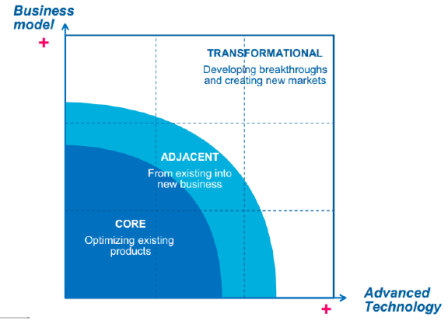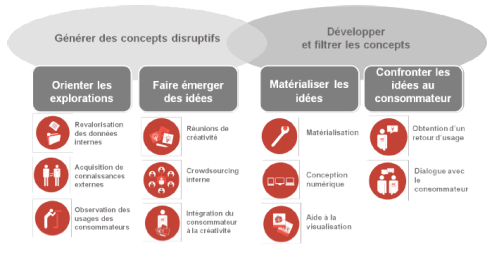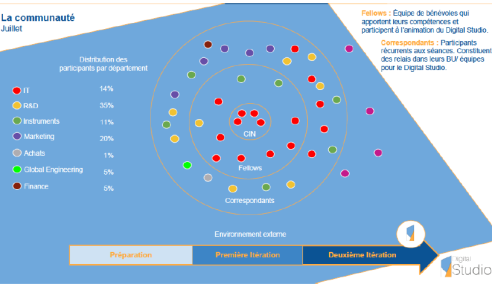Innovation labs or rapid innovation centers are developing at fast pace.
Just last week I was discussing about the set-up of an innovation lab in one African country where Orange operates. It often comes to the following 4 questions:
- What is the aim of the lab, and how will it operate?
- How to on-board and communicate?
- How to select the projects?
- How will it transform ideas to business, what will it deliver?
In this context, building on previous article related to open-innovation centers trend, I reached to sketch a typology of innovation labs, with 4 archetypes. Each of them illustrates a different intent, with a key pattern:
- Disruption;
- Speed;
- Openness;
- Innovation culture.
Each of them can inspire the managers in charge of creating an innovation lab, who can replicate one of the models, or improve the recipe, combining the different frames to design their own identity.
Let’s go first through some previous typologies that are presented in the innovation litterature.
4 types of innovation labs by Sihem Jouini
Sihem Jouini, an associate professor at HEC Business School and head of Innovation Design Majeure (PIC), defines innovation labs as follows:
- Innovation labs are designed to generate business opportunities, and execute actual exploration of valuable opportunities. The activities undertaken within the unit can progressively impact the current business units;
- They are spreading a culture of innovation, and innovation methodologies;
- They vary from a strict separation from the core company to a tight integration, leveraging the core co resources.
She sorts out 4 types of innovation labs (Ben Mahmoud-Jouini 2009, Ben Mahmoud-Jouini, Charue-Duboc 2012):
1) Explorator (BIG from Pernod Ricard, Valeo, i-Lab from Air Liquide)
The explorator lab aims at exploring adjacent or breakthrough activities, creating new markets, also called game-changers. It includes the following stages: opportunities identification, drawing on societal trends, concepts generation, knowledge acquisition, exploration strategy, actual exploration, hand-over to business-unit or spin-off / start-up creation. Communication can be internal as well as external: an explorator lab is a strategic move that can promoted outside.
Resources takes the form of a a legitimate lab manager mobilizing internal and external networks, a mix of employees and new hires, an autonomous budget, an openness to the ecosystem, establishing partnerships, and leveraging open innovation challenges.

2) Catalyst, Enabler (Snecma, SEB, Thales)
The catalyst lab coaches projects submitted by intrapreneurs or business units. It is working at promoting transversal initiatives across divisions, it monitors selection process, provides methodology, facilitates workshops, and supports up to POC delivery.
Resources are mixing innovation expert, and business expert. Internal communication to attract corporate entrepreneurs is a main endeavour. Budget is allocated as realization progresses.
 Seb Fab Lab
Seb Fab Lab
3) Facilitator (Innovation Room, Renault Creative Labs)
The facilitator lab is a dedicated room to stimulate creativity, creativity methodologies, training, light coaching, innovation culture. Internal communication targets all employees to entice idea sharing.
4) Connector (Essilor Digital Studio, BNP Paribas)
The connector lab is managing a community of innovators (fellows, correspondents), and organizes events for sharing experience. Internal communication is moulded in community management as its objective is to grow the community.

4 corporate entrepreneurship models from Wolcott and Lippitz
Another typology by Wolcott and Lippitz ranks innovation labs according to their budget allocation, and organizational ownership. It highlights 4 archetypes: the opportunist, the advocate, the enabler, and the producer. The advocate, enabler, and producer are quite close to the facilitator, explorer, and catalyst types reviewed previously.
![49115-si1-lo6[1]](https://nbry.files.wordpress.com/2018/04/49115-si1-lo61.png?w=496&h=379)
4 Explorative Innovation Units by Ralph-Christian Ohr and Frank Mattes
Ralph-Christian and Frank focus on explorative innovation units, working at playing field 3 of innovation:

1) Innovation Center is a Unit that supports business units in finding adjacent or even radical (technology) innovations and also explores entirely new growth options. The spawned innovations are mostly ‘physical’ (i.e. not primarily ‘digital’) or ‘digitally-enhanced’ in nature (e.g. smart surfaces). It meets the previous definition of Explorer.
2) Incubator stands for Unit that accommodates internal early-stage innovation ventures (often tied to Intrapreneurship) and provides critical services and resources for them to thrive. It meets the previous definition of Catalyst.
3) Accelerator accommodates external early-stage startups, and provides critical services, access to corporate assets/resources, and often funding capital to them, in return for stakes in the startup. This scope is reflected by e.g. Continental’s “co-pace” mission: “We broker, empower and leverage connections between emerging companies and businesses at Continental. Further we facilitate co-creation, from concept to proof of application”.
4) Digital Lab drives Digital Transformation by leveraging digital basic technologies (e.g. Big Data, AI, Blockchain etc.) for ‘Core Business Transformation’ (e.g. through process optimization or improved customer experience) and ‘New Business Creation’ (e.g. by developing X-as-a-service or data-driven business models).

4 Comments